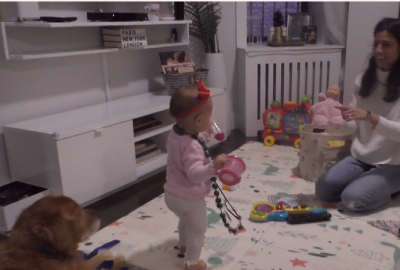
As families learn to adapt to a new normal in the context of COVID-19, parents wonder what they can do to best support their infants’ learning and development. How to keep babies busy between parents’ Zoom meetings, meal preparations, and chores? How to make the indoor environment as interesting and stimulating as a park or playground? What toys will ensure that babies stay interested and occupied?
Actually, infants do quite well when left to their own devices and they rarely tire out. Indeed, infants display tireless and exuberant activity as they explore their environments. They play with anything and everything available, even within the confines of the home. And infants’ eagerness to explore fosters all types of learning—fine motor skills, language, concepts about math and space, and so on. In this blog, we describe characteristics of infants’ everyday play as well as the benefits of play for learning and development.
Babies’ play is simple and complex; social and non-social; and involves toys, books, household objects or no objects at all! Our research (funded by the LEGO Foundation and the National Institute of Health), based on hundreds of video recordings in the homes of New York families, reveals the varied nature of infant everyday play.
The adaptive benefits of exuberant play
Parents often buy elaborate and colorful toys specifically designed for children. However, infants do not only play with toys. Babies love to play with common household objects such as boxes, blankets, and bowls. They enjoy banging on pots and pans as much as playing with stuffed animals. In essence, any object is a potential play object. Sometimes, even when surrounded by toys, children still choose to play with ordinary everyday objects. This video shows a 14-month-old playing in her home. She is wearing her mother’s necklace and pretending to talk on the “phone” using a remote control. Indeed, every baby in our studies showed us that colorful child-designed toys are not necessary to instigate play. On average, infants spend half their time interacting with everyday objects—pillows, boxes, doors, and containers. So, if you’re worrying about what toy to buy next, consider letting your baby play with the packaging that holds blocks or with the Tupperware containers inside your cabinets.
Do parents have to participate to ensure that their babies will play? No! Only half of children’s play bouts involved a parent. When parents are occupied, children find ways to entertain themselves with whatever is at hand. Thus, play does not require a playmate, and parents don’t need to constantly occupy their infants. In the video above, the girl continually discovered new things for independent play.
However, parents can intersperse their work and chores with short play breaks with their infants to take play to the next level. Play with parents promotes longer and more complex episodes of play. For example, this video shows shared play with a baby doll. The mother picked up the doll and the baby fed it. When the mother joined, she exposed her infant to words like “doll,” “juice,” and “bottle” that the infant would not have heard if playing alone. The mother also kept the baby engaged by jointly playing with the doll. When playing with infants, parents naturally create narratives about toys or objects that encourage infants to use their imagination—pretending that a bowl is a hat or that the dolly is hungry and wants a bottle. Our research shows that such elaborate forms of play occur when caregivers join in.
But much of infants’ play does not involve objects. Likely, your baby constantly moves around (crawling, scooting, bum shuffling, cruising, walking, climbing on furniture, oh my!). You may be concerned that your baby doesn’t sit still. That’s ok! Exuberant physical activity critically defines play. When infants are free to move outside the confines of playpens, highchairs, and other devices, they are in motion up to 40% of the time. Short spurts of locomotion are interspersed with longer stationary periods. It’s important for infants to practice different ways of moving. As infants explore their environments and navigate obstacles, they learn flexible ways to use their bodies. In the five minutes of play shown in this sped up video, the infant took dozens of steps across different surfaces and in different locations. Even in the home, infants find unlimited opportunities to move.
Why you should encourage your infant to play
Infants may not seem to be doing much when they play, but in reality, they are learning about the world when they babble on a pretend phone, feed a dolly, and zig zag around a room. In fact, extensive research shows that play drives learning and development.
Infants’ play supports development across domains. Consider a parent and infant playing with blocks. When the baby grasps a block and orients it to fit into the holes of a shape-sorter toy, the baby practices fine motor skills. Such skills emerge early in development and are foundational for movements that entail high manual precision such as zipping a jacket, typing on a computer, and opening a door with a key. Often, infants don’t play with toys in the ways that manufacturers designed. Babies may hold a block in each hand and run across the room to dump them somewhere. This is play! Infants practice balance control while running across a room, the foundation for gross motor skills. Caregivers should allow infants time to move feely before joining them in play. Then parents can encourage infants to stack the blocks into a tower. Play that involves other people strengthens infants’ social skills including the ability to take turns, understand someone else’s perspective, and respond to their playmate’s desires and intentions. If the tower falls over, infants are challenged to regulate their emotions. Play encourages infants to be patient and to persist at their goals. Finally, play affords opportunities to count and talk about colors, shapes, and orientations, and even simply moving across a room supports children’s growing understanding about space. Such activities support infants’ language and cognitive skills including math and spatial reasoning.
Parenting during a pandemic does not require creating a classroom play curriculum. Infant play does not follow a schedule, nor does it need to be highly structured. Play can occur any time—during meals, diaper changes, and baths. Infants may run around during your Zoom call and you may wish you could just go to the park like you did before COVID-19. Take a breath and keep in mind that even at home, as your baby runs around in the background of your work meeting, “learning is at play”. When your meeting ends, joining your baby in play may be fun for you too.
Catalina Suarez-Rivera, Ph.D.
Sandy Gonzalez, Ph.D.
Orit Herzberg, DPT.
Postdoctoral Fellows in New York University’s Institute of Human Development and Social Change (IHDSC) mentored by Professors Catherine Tamis-LeMonda (Play & Language Lab) and Karen Adolph (Infant Action Lab).


